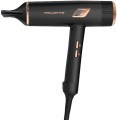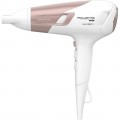Motor type
The type of electric motor installed in the hair dryer.
This parameter is specified if the device does not use a traditional collector (brush) direct current (DC) electric motor, but more advanced motor. The options here might be:
—
AC motor. Hair dryers equipped with alternating current (AC) motors use the same type of power found in regular electrical outlets. These AC motors offer several key advantages over their DC counterparts, including enhanced reliability, durability, and excellent resistance to high loads. They can operate at full power for extended periods without overheating, often lasting for at least 5 years even under continuous use. Additionally, AC motors provide more even heating and facilitate quick adjustments to temperature settings. As a result, hair dryers with AC motors are essential tools in professional settings such as hairdressers and beauty salons. However, the main drawback of AC motors is their relatively higher cost, making them less practical for occasional home use.
—
Brushless motor. A brushless electric motor, which eliminates the need for a traditional commutator and brush contacts, employs a built-in electronic circuit to control the current in the motor windings. Despite being more expensive than conventional brushed motors, they offer several advantages. These motors allow for more precise and wider range adjustments of engine speed an
...d airflow, resulting in higher efficiency and better overall performance for the same power consumption. Moreover, the absence of moving brush components enhances their durability, leading to significantly longer service lives compared to both AC and traditional brushed motors. However, due to their higher cost, brushless models are not widely used even in the professional industry.Power
The rated power of the device, in fact, is the power consumed by it when operating at maximum intensity.
The power of a hair dryer, particularly for hair dryers, is a crucial factor that determines the maximum intensity of the airflow and heating capabilities. When selecting a hair dryer based on this parameter, it's essential to consider the intended usage of the device. Models with a power below 1000 W may not be sufficient for proper hair drying, especially for long hair, and are more suitable for styling purposes. Some of these models, particularly inexpensive ones, can provide high heat with low airflow, requiring careful use. For versatile and effective use, both at home and in professional settings, it's recommended to choose a hair dryer with at least 1800 W, preferably
2000 W and higher. Higher power allows for intense airflow, effective hair drying even at lower temperatures, and provides a wide range of temperature and speed settings. Models with intermediate power levels, ranging from 1000 to 1800 W, are more suitable for travel and on-the-go use.
For curling irons, electric curlers, and similar devices, the heating intensity and speed depend directly on the power. The manufacturer carefully selects the heater's power to achieve specific performance characteristics, such as temperature and heating intensity. When choosing such devices, it's essential to focus on practical indicators and compare different mode
...ls based on power, especially if specific characteristics are not clearly stated, as seen in some inexpensive curling irons with basic functionality. In these cases, users should consider the weaker and more delicate their hair, the lower the temperature and less intense the heating should be. If unsure, it's safer to opt for a less powerful device, as it may take more time to curl hair, but it significantly reduces the risk of damaging the hair.Power modes
The number of power modes provided in the design of the tool.
This parameter is relevant primarily for hair dryers of various types (see "Device") — in models of another type, the main point is the temperature modes, see below for them. And in hair dryers, the number of power modes is, most often, the number of speeds at which the “blower” can operate.
The abundance of speeds allows you to choose the best option depending on the current task (quick dry, delicately style), hair type, etc. At the same time, the abundance of adjustments complicates the design and affects the price. Therefore, for domestic use, 2 – 3 modes are usually quite enough, and sometimes one is enough.
Note that in single-speed hair dryers, the number of modes may not be indicated at all.
Nozzles and accessories
—
Concentrator. Nozzle used in hair dryers to narrow the air flow, providing a more directed and intense blowing. Usually, it has the form of a nozzle that “flattens” the air flow from round to flat.
—
Diffuser. Nozzle that diffuses the air flow. Perfect for sensitive hair and prevents damage. Also, in some cases, provides more efficient styling.
—
Brush. Comb-brush attachment, mainly used for hair styling. Brushes can have a different design — for example, there are both round (cylindrical), with pins sticking out in all directions from the nozzle, and more traditional flat ones. Pins can also have different lengths, density and be made of different materials.
—
Straight. In this case, we mean a standard nozzle for curling irons (see "Device"). It is a cylindrical heating element designed for classic curling and most often supplemented with a hair clip, almost the entire length of the nozzle.
—
Conical. A variety of nozzles used in curling irons. It is similar in design to the classic straight, but it has a conical rather than cylindrical shape, tapering from the handle to the end. In addition, such accessories usually do not have crimpers. The cone nozzle is more difficult to handle than the straight one, but at the same time it allows for more strokes and gives m
...ore space for creativity (in particular, the diameter of the curl can be changed by winding the hair closer or further from the handle).
— Spiral. Nozzles for curling irons with a spiral slot on the surface. When used, this slot plays the role of a guide — a curled strand of hair is placed into it, wound on a heater; the end of the strand is usually fixed with a small clamp near the handle. In a certain sense, working with spiral nozzles is easier than with traditional straight ones — in fact, there is a “tip” on the nozzle for the user, and for an effective and pleasant-looking curl, it is enough to follow this “tip”. On the other hand, the functionality of such devices is narrower — curled curls have a strictly defined shape, depending on the size and angle of the spiral turns.
— Double. Hair curler nozzle, consisting of two cylindrical working surfaces, each with its own heater. The design of such a nozzle can be different: in some models it looks like a characteristic “fork” with teeth of the same or different diameters, in others each cylinder is located on its own half of the crimpers, and the heaters are side by side when closed. Anyway, such a device provides interesting additional features that are not available with more traditional single nozzles; but the specific possibilities may be different, depending just on the design. For example, a “fork” allows you to create curls in the form of zigzags, and with the help of a clamp, you can form waves of a small volume, but strictly the same size. However, for a number of reasons, double nozzles have not received much distribution — the triple ones described below are more popular.
— Triple. Further development of the idea embodied in double nozzles. In accordance with the name, such nozzles are equipped with three working surfaces of a cylindrical (or similar) shape. Usually, the whole structure looks like crimpers, while the extreme heaters are on one half of the crimpers, and the middle one is on the other. Triple nozzles are used mainly for hair with small waves: they allow you to easily create numerous such waves, and all the bends will be the same size. And in separate curling irons — for the same purpose — not even three, but five heaters are provided, with a similar design principle (through one on different halves of the crimpers); such “five” nozzles are similar in purpose to triple ones, but their presence is specified separately.
— Straightener. Nozzle for straightening (smoothing) curly hair. Usually it has the form of crimpers with flat heating plates: a strand of hair is clamped between these plates, after which the crimpers are pulled along the entire length of the strand, straightening the hair.
— Hair crimper. Nozzle for giving strands a zigzag shape. It has the appearance of crimpers with characteristic corrugated plates. The shape and size of such plates can be different — accordingly, the laying result will also differ: zigzags can be sharp or smooth, large or small, etc.
— Heat resistant mat. A special mat made of heat-resistant material, on which you can put a heated tool without fear that the heated nozzle will damage the countertop. Thus, in short breaks during work, as well as during cooling, there is no need to look for an improvised stand or other way of safe placement. So a thermal mat can significantly "make life easier" for users — especially for those who use the tool often and a lot, for example, stylists in beauty salons. And in some models, these accessories also perform the function of a cover — for storing and transporting the device with set of nozzles. Note that heat resistant mats are mainly equipped with “contact” type tools, such as curling irons and stylers; however, such a device may also be supplied with certain models of hair dryers.
— Heat resistant glove. Protective glove made of heat-resistant material with low thermal conductivity. It protects the user's hand from high temperatures, which are often used when working with hair, and also provides some additional features: for example, with a hand in a heat resistant glove, you can straighten the curl right on the nozzle of the curling iron without fear of getting burned. Also note that curling irons equipped with such an accessory usually do not have their own clamp, and it would be difficult, if not impossible, to work with such a device without a protective glove.
— Cover/case. The tool for storing and transporting the device. It is customary to call covers products made of soft materials, cases — made of solid ones; the former are less bulky and can be folded compactly when not needed, while the latter provide better protection. The specific type of device should be specified separately, however, a complete cover/case will be more convenient than improvised packaging anyway.
Note that in addition to the above, modern curling irons and hair dryers may include other nozzles. However, these are usually rather rare accessories, mainly needed for some specific tasks, such as creating designer hairstyles.Hanging loop
A special loop that allows you to hang the device on a nail, hook or other similar device. In some cases, this storage method is the most convenient — for example, a hair dryer or curling iron can be kept on the wall near the mirror, in front of which hair is usually dried and styled, while the device will always be at hand and will not take up space on shelves or in drawers. The loop is most often located directly on the power cord, near the handle.

